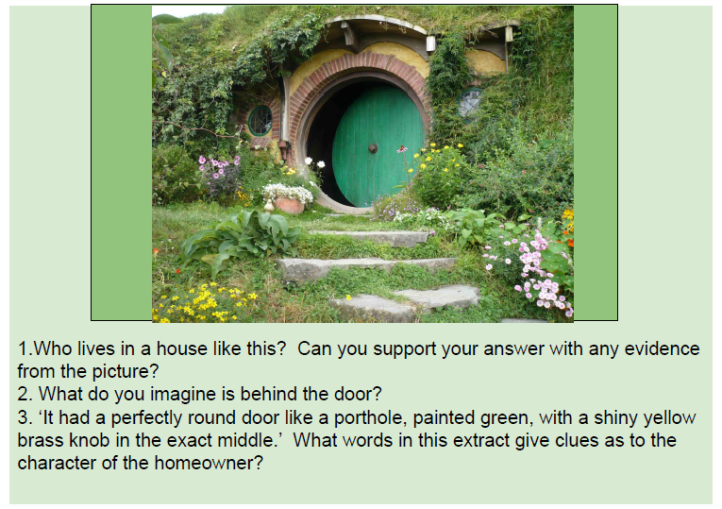I love to use classic and challenging texts in guided reading sessions ( even more so if there is a film or graphic novel version of the text to really help to contextualise for my EAL students ). One of my absolute favourites is ‘The Hobbit’ which I have used with Year 5 and 6 pupils over the past 20 years (wincing slightly at the size of that number because in my head I am 27). Anything with a dragon in it is a winner in my book…
If you feel inspired to use a classic text then I advise you read the Bob Cox books on ‘Opening Doors’ which given practical approaches when using them to teach whole classes.
I always believe in starting a new text with activating schema, where I will encourage children to bring their prior knowledge to the text and make connections. For The Hobbit I set the scene by playing music from the sound track and sharing a variety of magical images from my collection…
After initial schema activation I like to do a bit of prediction and drip in inferential questioning throughout the teaching sequence. Inference is such a difficult concept and yet is very much favoured on the SATs papers so it needs to be explicitly taught, modeled and used frequently.

In a perfect world the full text should be available in class for reading by those children who are really switched on by the guided reading sessions, but free text extracts can be found online in a variety of places…
http://readingzone.com/index.php?zone=sz&page=extracts_download
https://www.writerswrite.com/books/excerpts/childrens/
https://www.worldbookday.com/resources/extracts/
http://www.lovereading4kids.co.uk/
I always make sure that fluency is part of the daily session and will share extracts of the start of the story, using fluency strategies such as cloze, choral and echo reading.

I would need to discuss the meaning of some of the vocabulary in context, but would plan to spend a least one guided reading lesson on investigating key words in more depth. In doing so I would look at etymology and morphology as well as multiple meanings in different contexts.
I believe fluency and vocabulary are still key teaching elements in a reading lesson – even in year 6 – and then, and only then, can you really hope that the children can infer….then work on exam rubric, which is the cherry on the icing on the cake!
What does the sentence ‘No going upstairs…’ tell you about hobbits? This is the ideal time to model thought processes, not expecting children to simply guess what is in your head. My explanation starts with ‘ Well maybe hobbits don’t like going upstairs so it could mean that they are a bit lazy or they avoid physical exertion, but it might also mean that hobbits find it difficult to get up and downstairs due to some physical constraint.’
Children can draw what they see in their minds eye – it is a great skill to get them to play ‘movies’ in their heads and acknowledge this by get them to visually represent what they are seeing there.
I tend to end a Year 6 session with a bit of exam rubric by formulating a SAT style question based on the text. It is important that they get to experience the kind of language and layout that they will come across in the test.
My children really struggle with the word ‘impression’ so my second session might end with the question ‘What impression do you get of the hobbit?’ – this would lead to either a written or an oral response that could be discussed.
This trailer is a lovely way of introducing the children to the hobbit, Bilbo Baggins, at the start of the next session (always watch videos first as you will know then whether it is suitable for your pupils to view)…
For exam rubric questions I like to use the question stems from Primary English Educational Consultants.
Click to access 2015-GR-question-prompts_KS2.pdf
An interesting comparison can be made between the text and the opening of the 1977 animation…(I think I have a vague memory of this as a very young child!)
Which do the children prefer and why? What similarities are there? Why do they think the creators of the animation changed things?

I would continue reading, looking at the explanation of what a hobbit is, again using echo or choral reading to develop fluency for all. I would then discuss the explanation. For example the phrase ‘there is little or no magic about them’ indicates what? There is an expectation that magic is to be expected…so this cannot be our world…or at least as we know it today. Is there anything in the text that might make one think that this is our world in a time long gone?
I would discuss the meaning of the word blundering, asking children to see if there is information in the text to help understanding or if the suffix can help us know what type of word it is.
My session would end with an exam rubric question:
Circle one word below that best describes the character of a hobbit:
small frightened resentful respectable
There are endless activities and approaches which can be used with this wonderful book. The key elements to remember with any guided reading approach is that without fluency and understanding of key vocabulary there is no comprehension and that exam rubric needs to be built on strong foundation.